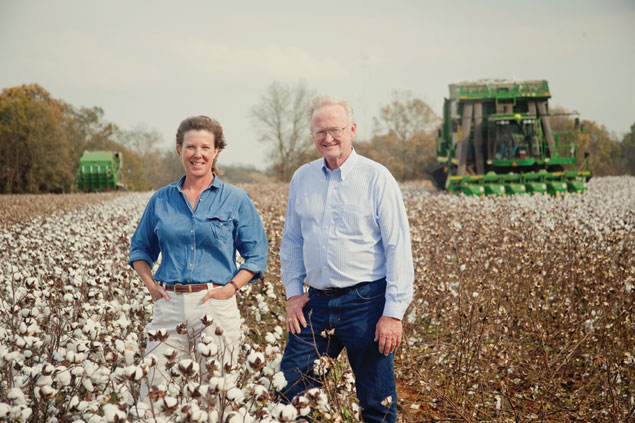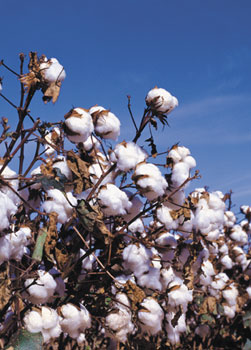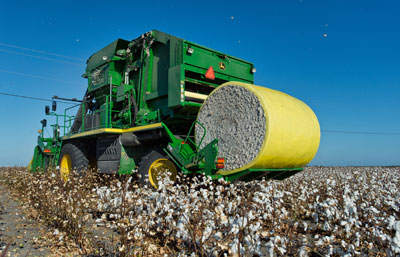A high-end John Deere cotton picker can cost more than $600,000 these days. That price tag prompted Farm Credit customers Jimmy Dodson from South Texas and Larkin Martin from northern Alabama to figure out a way to get two pickers for the price of one.
“By sharing, we have access to two pieces of equipment, but we only pay for one,” Martin explains. “We have less capital tied up in equipment.”
Typically, Dodson harvests cotton on his Robstown, Texas, farm between late July and August. In the past, he hired custom harvesters. Martin’s Courtland, Ala., operation usually harvests in September, using the family’s own machinery.

Larkin Martin of Courtland, Alabama, and Jimmy Dodson of Robstown, Texas.
Photo by Alicia Looney
For years as they met up at cotton industry meetings, the two talked about sharing equipment. They didn’t act on the idea until 2011, however, when they both were planning to purchase a new type of cotton picker that kicks out compressed round bales, the six-row John Deere 7760.
The equipment breakthrough, combined with heavy cotton demand and high cotton prices, made it the right time to upgrade.
Following is their advice on how to make sharing work.
1. Keep it simple by owning your own. Often, sharing equipment involves jointly owning machinery. Martin and Dodson simplified their deal by purchasing one picker each. “We settled on a lease agreement, where the cash exchanged is fairly minimal,” he reports. Each purchases insurance to cover the other’s equipment when it’s on their farm.
2. Work with a partner you can trust. “You’re operating and maintaining expensive equipment,” Martin says. “I knew of Jimmy’s reputation for hard work, honesty and being a good operator.” She and her farm manager visited him in Texas to see his operation before proceeding.
Martin’s dealer delivered her new machine to Dodson before she even saw it, because his harvest came first. “Larkin had to trust me, since we could have delayed her harvest,” Dodson says. “She is quite brilliant and a great leader, as was her late father, Sykes Martin. “I knew I could trust her to take care of the machinery and follow through with commitments.”
3. Find someone who won’t need the equipment when you do. “You’ve got to be geographically separate enough to minimize the risk of overlapping needs,” Martin says. She and Dodson compared records. Their harvests overlapped in just one of the past 20 years.

4. Spell out details in a formal agreement. Dodson and Martin recommend putting details on paper to avoid misunderstandings. For example, their legal document states that her machine will always be available to her when she needs it, and his will always be available to him when needed. Dodson’s operators will run the pickers when they’re at his farm, and Martin’s employees will operate them at hers.
5. Decide how to handle unequal use. “We typically use the machines a similar number of hours in each location, and we compensate the other with an hourly rate if there is an imbalance,” Dodson says.
6. Agree on maintenance procedures. With shared equipment, the machines’ lives may be shortened because they’re used for more hours, and they may need more maintenance. Martin and Dodson’s agreement spells out how to handle breakdowns and year-end maintenance.
7. Determine how to pay for transportation. Martin and Dodson share most transportation costs. Their equipment dealers cooperate to break down the equipment and transport it using a truck and trailer rig. “If there are extra setup costs at my dealer versus what’s normally paid in Alabama, then I pick them up,” Dodson says.
8. Own the same type of equipment. It works best if both parties own the same type of equipment from the same manufacturer that is the same size, so they can use the same supplies, from parts and grease to transport tarps. Last year, Martin traded in her new picker for an even newer model. “There was a hot market for used, and I got a good deal on a new one,” she explains. Dodson wanted the new model, too, but his dealer couldn’t obtain it. “It’s better to have the trades move in concert for fairness,” he says.
Sharing equipment comes with pros and cons, but it has worked well for these two farmers. They plan to continue sharing, unless they foresee a big drop in cotton prices, along with a decline in their cotton acreage.
-Nancy Jorgenson
New Pickers Come With Benefits

Photo by Eddie Seal
Larkin Martin and Jimmy Dodson both knew they wanted to purchase an innovative new type of cotton picker — but they also knew it would be expensive.
“By buying the new-model pickers and sharing, we save money, steel, diesel and people,” Martin says.
Older-model pickers dump fluffy cotton into a buggy that runs alongside the picker, and require moduling machines that compress the cotton for transport to the gin. The new 7760 picker eliminates the need for the buggy and the moduling equipment, plus their operators. It also saves time because it doesn’t stop to dump cotton. Other manufacturers make similar versions.
“You gain efficiency because you can pick more acres a day,” Martin says. “But you’ve got to spread your costs across a large number of acres to make the investment pay. I wanted to raise more cotton than one machine could handle, but we wouldn’t have bought two pickers on our own — it’s a luxury we couldn’t afford.”
Deere Credit financed the pickers. For other loans, Martin and Dodson depend on Farm Credit. Texas AgFinance finances much of Dodson’s operation, while Alabama Farm Credit finances the Martin family’s land purchases.
Would Sharing Work for You?
The idea of sharing equipment isn’t limited to the cotton industry. If you grow wheat or corn, you might consider sharing combines with a producer who lives farther north and harvests later in the season.
It may be too soon to call sharing a trend, but Danny Klinefelter, a professor with Texas A&M University, sees farmers sharing across the nation. Canadian farmers have formed their own machinery cooperatives, and the University of Iowa offers fact sheets online about farm machinery joint ownership.
– Nancy Jorgenson
A Portrait of Two Industry Leaders
Larkin Martin
Martin’s family has grown cotton in northwestern Alabama since 1817. When her father was diagnosed with cancer in 1990, she left a career in Washington, D.C., and returned home to run the farm. She and her husband, who works off the farm, have four children ranging from middle-school age to adulthood. Her three sisters aren’t involved in day-to-day operations but own shares in the farm. A former board chairman of the Federal Reserve Bank of Atlanta, Martin represents Alabama on the National Cotton Board. She recently earned an Eisenhower Fellowship that allowed her to study agriculture in Turkey and Kenya.
Jimmy Dodson
Dodson’s family has farmed near Corpus Christi for three generations, and they currently grow cotton and milo and operate a seed sales business. He and his wife, Barbara, have three grown children. Barbara works in the farm office, and he farms with their children and a cousin. Dodson is board chairman of the Farm Credit Bank of Texas, which provides wholesale funding to Farm Credit cooperatives from New Mexico to Alabama. He’s also vice chairman of the National Cotton Council, former chairman of American Cotton Producers and the Cotton Foundation, and a past director of Cotton Incorporated.